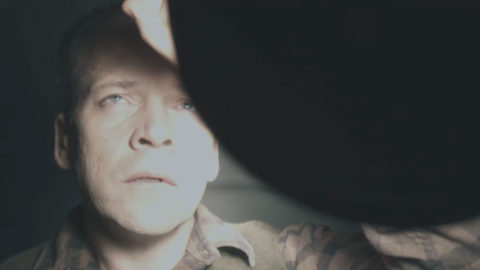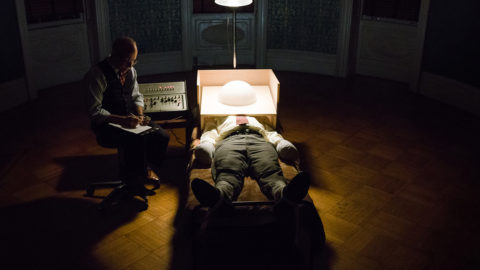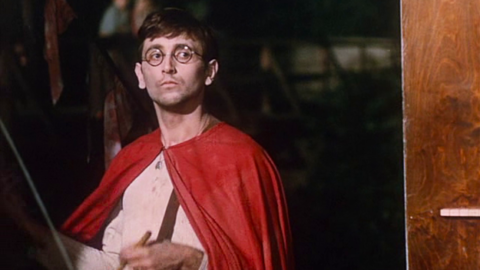Interview: Katharina Wyss
In our January/February issue, the Currents section began with a focus on Sarah Plays a Werewolf, which has its North American premiere in Film Comment Selects: “Berlin-based Katharina Wyss’s heady debut feature centers on Sarah, a young woman channeling her powerful depth of feeling into the artistic and psychological outlet of theater. As the 17-year-old protagonist in a staid Swiss town, Loane Balthasar is unnervingly transparent, giving herself over to her character.” For Film Comment, Lily Majteles sat down with Wyss during her visit to New York and discussed vanquishing clichés about female coming-of-age, conspiracies of silence, and how she used inner monologues and Mike Leigh–inspired techniques in working with her young cast. Wyss appears for a Q&A after the screening.
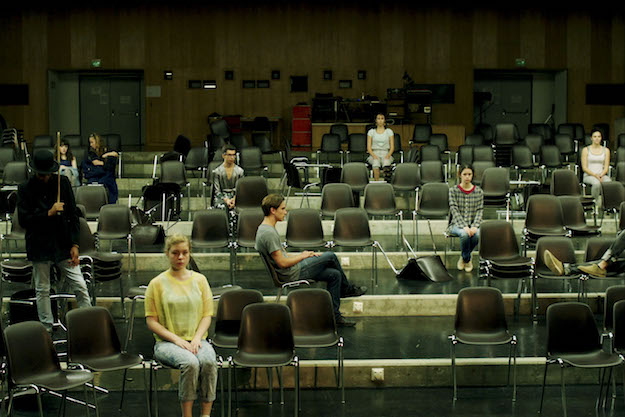
I’ve watched a lot of coming-of-age films about young women, and oftentimes they don’t ring true, but Sarah Plays a Werewolf really does. Where did the inspiration for the film come from?
When I was a teenager, I went a lot to the movies and saw a lot of films, and there was always this strange feeling that I felt: I always identified with male characters. So where is the film that’s going to show what my experience is as a girl? My experience wasn’t just that I was interested in boys—which I was also—but that I was reading, I was writing with my friends, and painting and doing all these things, and there was nothing like that. But then there was one exception I remember, from the French director Noémie Lvovsky, who made this film La Vie ne me fait pas peur (Life Doesn’t Scare Me), about girls who are 13. She made two or three films about a group of girls when they were kids, and then teenagers, and then a bit older. And that, for the first time, was something that was like, okay, this is my life in a movie. But that this was in the ’90s, and since then, a lot has happened, but still there is a feeling that something’s missing. And that’s why, for instance, I chose to have [the characters in Sarah Plays a Werewolf] writing and working on their theater play and being in this kind of activity.
The other thing is that it’s based on experiences I had taken with me from that time living in this small town in Switzerland, where the film was shot. There were these mysteries and unsolved questions about several suicides and also friends being in psychiatric clinics and struggling with bulimia. We didn’t know at the time even what it was, there was no name for those things, we didn’t talk about that stuff so much. But it was something about not knowing how it happened, and how you respond to that kind of violence—you don’t know where it comes from or what to make of it. So it started with research on mostly one story, then others came, and it was an attempt at a reconstruction, to try to get the puzzle pieces together. Which is why I like the Errol Morris film Wormwood a lot, because I can understand this Eric Olson guy. Often when these mysterious things happen, they stay mysterious, because they happen at a time when you’re young and you don’t get the whole story. And maybe I know the whole story now, but what I really wanted to do was to give the feeling of being in the middle of it and not knowing
I think I put the viewer in that position, too, because I didn’t want to make a film where you know more or know better than Sarah does. It was always to bring somebody into the labyrinth and these emotions that she experiences without being able to sort everything out. I could have told it in the past tense, but I really wanted to put it in a present situation, which is also how it is at this age, where you’re just in the moment. So the structure starts with the ending: at the beginning you hear the helicopter, which you hear again in the end. It was like taking somebody out of this grave, and letting them live again for a while.
What did you do visually to bring the viewer inside Sarah’s head?
Maybe this is not visually, but with the writing, I asked my co-writer Josa Sesink to write inner monologues for Sarah. He became like Sarah—he wrote all these inner monologues for all the scenes I had for her. In the beginning, one inspiration was Arthur Schnitzler, the Austrian writer, like “Fräulein Else,” and the literary monologue style he invented in the 20th century. That style really impressed me. So I said, okay, this is cinema, we cannot say an inner monologue, but let’s have this level where we write the inner monologues and then take them out again, and from there we change the scenes. That was one technique. Visually, I think we were not looking to make it totally subjective. It was more staying on the outside, a lot of close-ups… When you have a person in a certain situation, the way it is directed and framed tells you what the state of mind is for this person, in this situation. Not so much this thing where you always follow somebody with the handheld camera, or where you go into very blurry, subjective pictures—I wasn’t looking for stuff like that. It was about trying to get to being with her, with the whole space of the city and a lot of inner space. So there was a perception of being in her mind all the time, and maybe this is just her world, which seems objective to us.
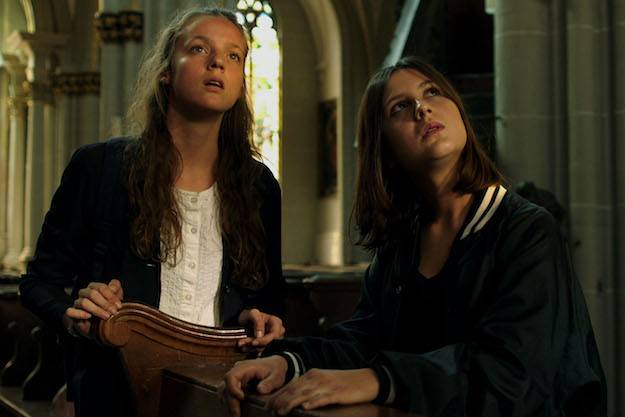
I loved when you shot Sarah in close-up because that actress, Loane Balthasar, is incredible. Whenever the camera was close on her face, I really felt her intensity. What was the process for casting that role, and how did you get her to maintain that level of intensity?
It was always my ambition for this film to discover an actress who had never acted before. There’s this film from Claude Goretta, who is a Swiss filmmaker too, called La Dentellière—The Lacemaker—and it was with Isabelle Huppert when she was 19. She had shot other films before this, but still it was one of the earliest films she made, and I thought, “I need to find her! Maybe I am not going to find Isabelle Huppert, but somehow…” The world in which I shot and cast the film is a really small one. Switzerland is small, but the French spot of Switzerland is even smaller, very small. And Fribourg is on the language border, between French and German, so first I worked a lot with teenagers in the city during script-writing. I did workshops, invited them and taught them what I could about film acting, and they gave me input about the story. We had no casting agent. I had a friend who was a theater director, and she had started to do some casting for this part of Switzerland, because there was nobody really. The actors are not in agencies. They are in Germany or France, but there is no infrastructure like what you might have there or in the U.S. In this milieu, the kids are not poor kids—they are going to school and they do theater classes and music classes and literary classes and everything. So we went into these theater groups in school, and then in this one class, there was one girl—Loane—that the teacher told me was really special. And I met her, and I did the casting with her, and immediately I realized there was something very, very different and special. I tried a few things and I saw how much she was able to express emotions and how easy it was to work with her and to get her from one stage to the next. Then I thought like in Mulholland Drive: “This is The Girl!” Then I cast all the others, and I asked her to do some additional exercises. I just realized that she was really able to make things on her own. We did test readings for three days together, just the two of us and the camera, and we didn’t talk a lot. I think I told her once that I thought she should have her own relationship with Sarah. And it didn’t really belong to me, whatever relationship this would be. She would have her story and it was none of my business. And I think she took this really seriously.
Then I orchestrated meetings with the other actors. She wasn’t with the group—they met, so they knew each other first, and she was kept apart, outside a little bit, and then I brought her in, so she could use this aspect of the casting process later on. I once had a workshop with Mike Leigh, and he told us about his crazy rehearsal process for three months: the actors don’t know the script, and they don’t know if they are main characters or not, and he just builds up every character with every actor, with the costume designers, and set designers. And then he makes them do an improvisation where they meet, in a scene, as the characters. Each character has a chance to be built up itself, and no one has the feeling of, “Oh, I’m just a side character.” So you can use improvisation to get to that stage and then we rewrite, so when you shoot and direct you really know what you are doing.
Because I was working with all these young kids who had never acted before, and I knew the journey, especially for Loane, was also a dangerous one, because you have to go into fiction and it can become very real, in terms of emotions when you act, when you don’t know how to handle it—that these emotions are real, but I’m just working with them. So I tried to build up characters with everybody, so everybody would be protected, so we could go as far as possible with the story. But still it was a dangerous journey, especially with Loane. It’s really incredible what she did, having absolutely no experience, at her age and everything. It’s just great. She keeps winning these prizes now. I didn’t want to push her afterward—maybe she wants to do something else in her life. But she wants to keep acting.
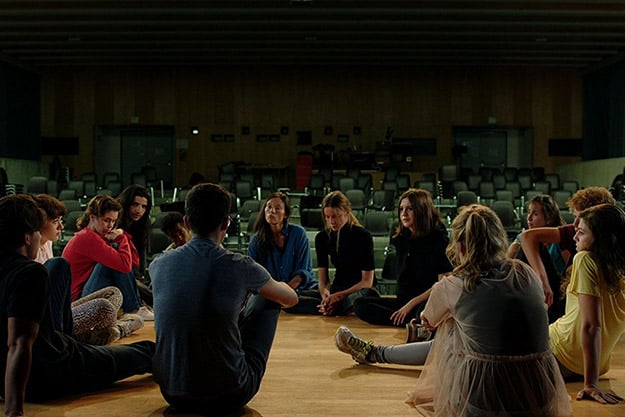
I’m glad you brought up Isabelle Huppert—that’s exactly who I was thinking of when I think of actresses who can bring that intensity. What films inspired Sarah Plays a Werewolf?
There were different films that were important, but didn’t really influence it. In the beginning, there were a lot of films where somebody commits suicide at the end, like Mouchette from Bresson, but it’s absolutely not the style and not the way of filmmaking—just the way he told the story of that girl. That really touched me. There was also Last Days from Gus Van Sant, which is also a totally different style. But then the more I got into the story of abuse that’s in it—hidden, but it’s in it—there was a film that impressed me by Sion Sono, which I think is the most violent but most honest film about this subject. The films that were important earlier were also Fassbinder’s, of course. The colors and the visual style were much more inspired by the city itself: for example, the church, and the colors of the church windows.
I saw that [the Film Society] did a retrospective of Raul Ruiz films, and for me, Raul Ruiz was really important. Also Marcel Proust, and Time Regained, spoke to my obsession with going back to the past and living there and living with characters of the past. How Raul Ruiz managed to make this film from this book—it’s just so crazy, and it’s just so great. What I really love about Raul Ruiz is his way of focusing on scenes and jumping from one to another—it’s about memory of course, and he has a different approach of time and going from one scene to another. For instance, a lot of directors shoot people walking from one place to another, and filling all the gaps between one to another, and this is something I don’t do. I always think maybe I should do it to be normal, but I’m not so interested. So Ruiz is a good reference, and Time Regained, because it is really like a mindspace, a space in memory where characters come in and out. Also with Schnitzler, his psychoanalysis was really important in this time, his writing about how the stories you try to rebuild from the past are kind of fragmented. It’s more a mindspace that you’re telling, and maybe this will be the more accurate thing to show, because the other one is more superficial. You’re using reality, of course, because it’s life, but that’s what’s great about cinema.
There are things in the story, certainly suicide, that are universal to everyone, but are there aspects of Sarah’s story that are unique to female coming-of-age?
Boys may also have this, but there’s something [female] about not saying what you think, you know? And letting other people speak for you. So that’s the problem, of course, with the father, that he speaks for her all the time. And she keeps her mouth shut. That’s why I have the ending where she’s writing the name. If she could have gone on, maybe she could have written more and put her name out there and spoken for herself. But it’s also like a lot of films I have seen this year, for example, The Killing of a Sacred Deer. What Yorgos Lanthimos did which is really great is that he tells this story of a patriarchal system in this almost ancient Greek way which has been going on for thousands of years: this Roman law that the father can decide on the life of everybody else in the house. He can decide if someone should get killed. And this is a structure that we should try to get rid of. It’s been changed in the law, but a lot of things from a long time ago have not been changed. So, for me, it’s not so much about men and women, but about who’s a victim of this system—it can be a man and it can be a woman. I also saw the Lynne Ramsay film the same evening, and what I found really interesting about her film was that it had him and her being two victims of this thing, where these guys in power decide for everyone around them. In the Lanthimos film, this guy isn’t able to admit that he committed a crime, or failed. So everyone has to die around him. And this kind of thing has been more present for women, of course.
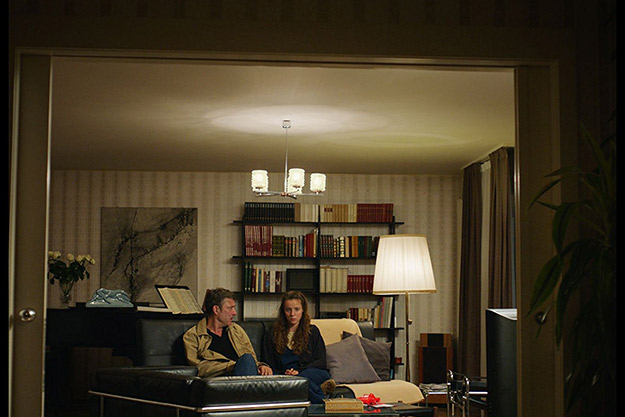
I thought of Lanthimos a lot when watching your film, because of how he explores the family. I enjoyed how you portrayed the complexities and contradictions that come with family and how a young person learns to cope with their family situation.
I was interested in the closed system of a family. This idea that everything’s okay, because we are in this family in this normal world, it’s fine, and we should keep it that way and we shouldn’t question things too much, because it’s better to suffer a little bit, or maybe even to suffer very much, than to even question the structure. You can see that on a bigger scale, even a country, like Switzerland—it can become a metaphor for that. We have someone going crazy in our community, so we have this reflex to say, “This is one crazy person, and we’re going to exclude her and say the only problem is with her, so let’s lock them away.” That’s something interesting about these suicide stories of my youth: it was always about a girl, and how she has a strange character, or she is weird, or she has too much imagination, or she’s too much of a perfectionist, so that’s why she killed herself. And this was always the thing, in all the stories I heard. To not see a young person as some kind of victim of something. That’s a really dangerous mechanism, in a society, when we stop having solidarity with the people who break, because they are the ones who are symptoms of larger violence.
When you were developing your first film, did you know you wanted to explore these suicides?
It was always there. I painted a lot when I was a teenager, and then I made this series of paintings about this thing. And then when I applied to film school, it was one of the stories that I always had. You have to sort out some stories so that you can tell other stories. It’s a problem, because you always come to problems in the storytelling because you haven’t solved these things.
How many years did it take to get the film made?
Oh, it was awful. It took a lot of years. I don’t know if it was my fault, or anybody else’s, but from the first moment I researched, it was seven years. I worked in advertising and did a lot of stuff, but it was actually stupid, because in the end we had a budget of a million or so Euros, which is not so bad for a first film, but still, it took a long time to convince everybody and also for myself to find the story.
So do you want to make films with larger productions and larger budgets in the future?
It would be great, but I don’t know… I don’t know if I can choose that, right? The question would then be, if somebody would actually give it me, which, statistically, is not so probable. In Germany there are also a lot of discussions being had right now about woman directors—who’s actually working and who’s getting the big budgets. Statistically, my chances are still not so high to get a big budget. And then the question is, how do you compromise? For instance, with the story I’ve been researching, I think you could make a pretty commercial thing with it, but I’m not interested in telling the reality of that story in that way.
Are you optimistic about the future for women filmmakers?
What else could I be, right? I cannot be depressed. It’s really hard to act out of depression. But I think with everything it’s good to be aware of how things work and not just be locked in this feeling of “I’m not good enough” or “I’m the problem,” but just to understand the many levels: where it’s your fault, and where it’s not, and where you can work as hard as you want and never get anything—which also happens. It helps to understand it.
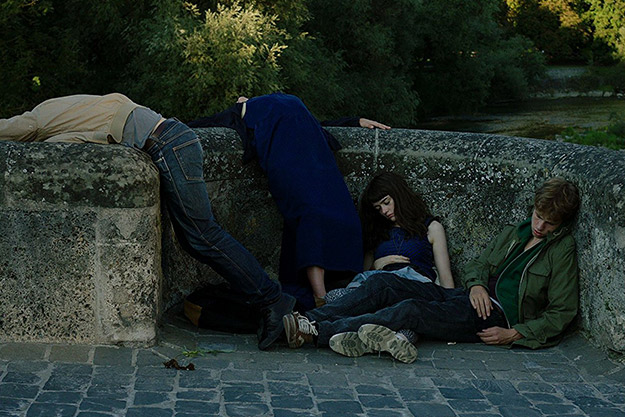
I was fascinated by how Sarah embodies so many different contradictions. She is both wise and naive, and theater is both helping her and hurting her. What was the process of developing her as a character?
That was really important. There’s something about female protagonists, and especially this idea that maybe you can make her a very nice girl and then a terribly sad victim and you can have great empathy, because she’s so lovely and funny and everything, but I wanted to give her sides that are not nice, to make her actually a person. That was really important, to make her full in that sense. Confronting reality and trying to look at it and trying to understand another way to tell things and not just follow some cliché that’s been implemented in your brain that says the girl should be like this or like that—which you get from somewhere, of course. There’s a kind of dominant culture which is always in your brain and makes you think things should be like that. And I guess people are somehow relieved to just watch it the way they think it should be. But I think it’s not interesting. I like when somebody shows me something in a way that makes me think: “Ah, okay, right—that’s something I’ve always been seeing, but I never thought about why I was always looking at it like this.”
What do you want viewers to think when they leave the theater after the film?
I’ve felt, after the first screenings, that what’s beautiful about film is that it lives its own life. It is complete in the moment that somebody watches the film—and this I feel very much. I think that there’s a lot of intention when you write a film on a subject where you want people to think certain things or understand certain things, so you are manufacturing a thought process for the viewer. But then, of course, there are so many different stories that somebody has when they come to watch a film, so many different things they’re going to react to or not react to. It’s a bit like what I said about Loane and Sarah: as I told her, you have your story with that character. People are going to have their story. It’s not about, “I don’t want to explain to people what my film is about.” I know what the film is about, and I want you to know it, I can tell it the clearest way, and I hope the communication is the making of the film—how well you make it. I know that sometimes some people go with it, and accept it, and take the journey, and for other ones it is difficult. That what’s beautiful about filmmaking.
The really beautiful thing also is not to be there, and never to know, actually, that somebody, in one cinema, in one moment, feels that something means something. And this is what I hope for, of course, that somebody cries or it touches somebody or helps or something. It’s really private. So also in the Q&A sometimes I don’t want to talk—it’s really a private thing you have with a film. Often when I watch the making-of for a film, and there are interviews with directors and so on, I regret it. Not because they are stupid people, but because I had a private story with this film for myself and I have a right to.
That’s quite similar to Sarah’s relationship with her play in the film. She tries to go to a very emotional place, but she finds that other people don’t understand what she’s trying to accomplish.
It’s a lot about that! I think also there’s a certain humor in this that I love. When I was with my friends as teenagers, we were pretty dark, we weren’t gothic, but still I was drawing a lot of monsters and violent things. It was a revelation for me when I read Georges Bataille. I was always attracted to that. When we were having dinner, my mother was always like: “I’m tired! When I come home from work, I don’t want to talk about the horrors that happen in the world, so please shut up!” And I was always like, “We have to talk about it!” A lot of teenagers are like that, because it’s this moment when you think you have to change the world and do something and there’s all this injustice. But in my experience, drawing monsters is something that make people look at you and think, “You must have a problem, because you are showing something violent when you draw a monster. What’s your problem?” And instead I think it’s just a pretty good way to give a reality, an artistic reality—because we are talking about art, it’s not like going out and killing people, it’s just art—to express these things. And it’s not you who is the monster, because the violence was committed somewhere else by somebody else. You’re just trying to visualize how it feels to be affected by it.
So then is Sarah’s play and her concept of “The Torturer” rooted in your own teenaged fascination with violence?
No, it was actually something [that came up] in the writing—I started to write about this imaginary room where Sarah was meeting this man and talking to him and so on, and then we came to this torture. It’s a way of talking about her father, and being fascinated by this and also feeling afterward that people are reacting in this way: “It’s terrible!” For her it’s also people telling her, “Look, we don’t want to hear your problem, actually.” And she gets the message: it’s nothing we want to hear. This is maybe something also about Switzerland—and in many other countries also—this general impression you get that people don’t want to hear your problems. They don’t want to hear if it’s not nice—you should just handle it yourself. I think it is isolating people a lot. Especially young people.
Sarah Plays a Werewolf screens February 25 in Film Comment Selects at the Film Society of Lincoln Center, with the kind support of the Consulate General of Switzerland in New York and Swiss Films.
Lily Majteles is a writer, filmmaker, and student at The New School’s Eugene Lang College of Liberal Arts.



